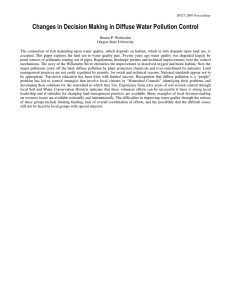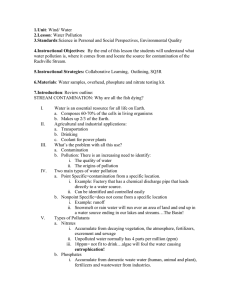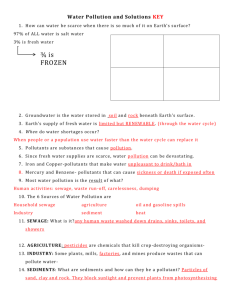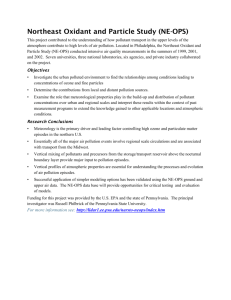Water Pollution Lesson Plan for Science 8
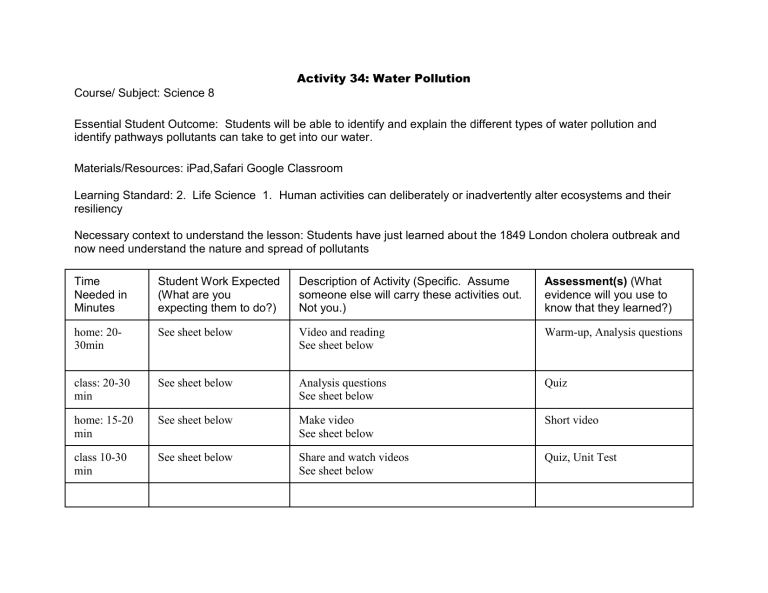
Activity 34: Water Pollution
Course/ Subject: Science 8
Essential Student Outcome: Students will be able to identify and explain the different types of water pollution and identify pathways pollutants can take to get into our water.
Materials/Resources: iPad,Safari Google Classroom
Learning Standard: 2. Life Science 1. Human activities can deliberately or inadvertently alter ecosystems and their resiliency
Necessary context to understand the lesson: Students have just learned about the 1849 London cholera outbreak and now need understand the nature and spread of pollutants
Time
Needed in
Minutes
Student Work Expected
(What are you expecting them to do?)
Description of Activity (Specific. Assume someone else will carry these activities out.
Not you.)
Assessment(s) (What evidence will you use to know that they learned?) home: 20-
30min
See sheet below Video and reading
See sheet below
Warm-up, Analysis questions
See sheet below Quiz class: 20-30 min home: 15-20 min class 10-30 min
See sheet below
See sheet below
Analysis questions
See sheet below
Make video
See sheet below
Share and watch videos
See sheet below
Short video
Quiz, Unit Test
Activity 34: Water Pollution
Do you know the different types of water pollution? Can you identify pathways pollutants can take to get into our water?
AT HOME: Tonight
1.Please watch this video:
Water Pollution, the Dirty Details https://www.youtube.com/watch?v=FOEN-8Nd2jI
2. Then read pages C21-27 in the textbook: http://ebooks.lab-aids.com/student-resources username: coalridge1 password: rmcdonald1
3. Be prepared for a short warm-up including a CANDY QUESTION
AT SCHOOL: Tomorrow
Please answer these analysis questions:
1. Based on the information from the reading, determine which type of contamination, biological or chemical, is present in the following scenarios. Explain.
a.Thousands of cars travel on city roads every day. The tires rub against the road and leave behind small flakes of rubber.
When the brakes are used, tiny amounts of copper flake off. Eventually the rubber and copper get washed into streams and rivers .
b. You wash your car with soap in the driveway. Soapy water drains down the gutter and into the storm drain, and eventually runs into a river, lake, or bay .
c. Scientists discovered that droppings from seagulls in a restored salt marsh were spreading to shallow ocean waters near a beach. Officials closed the beach to swimming because the bacterial contamination was thousands of times higher than the limit that people could safely be exposed to .
2. Explain how water contaminated from a mine could end up in the ocean 100 miles away .
3. Make a list of things you do every day that require clean and safe water .
4. Make a list of things you and your family regularly do that could threaten the water supply .
AT HOME: Tomorrow night
Find a possible source of water pollution that can come from your house. Make a short movie (iMovie, Explain Everything, etc) where you:
1. Identify yourself
2. Show the pollution source
3. Identify the type of pollutant
4. Explain and show the pathway the pollutant can take to get into the water supply
Post the video to Google Classroom and be prepared to share in class.







